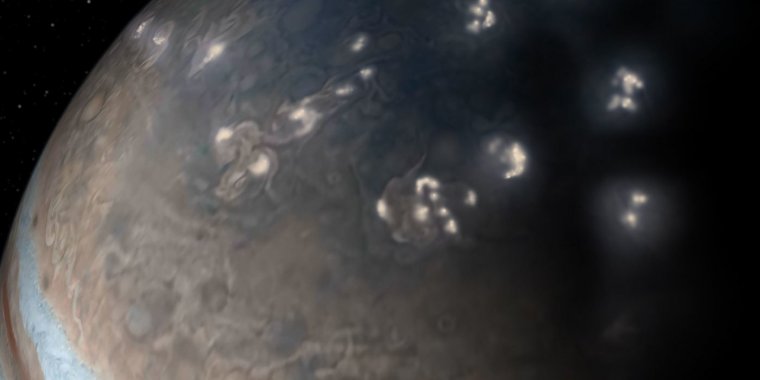| News / Space News |
Juno Solves 39-Year Old Mystery of Jupiter Lightning
Ever since NASA's Voyager 1 spacecraft flew past Jupiter in March, 1979, scientists have wondered about the origin of Jupiter's lightning. That encounter confirmed the existence of Jovian lightning. But when the venerable explorer hurtled by, the data showed that the lightning-associated radio signals didn't match the details of the radio signals produced by lightning here at Earth.

Artist's concept of lightning distribution in Jupiter's northern hemisphere. Image credit: NASA/JPL-Caltech/SwRI/JunoCam
"No matter what planet you're on, lightning bolts act like radio transmitters -- sending out radio waves when they flash across a sky," said Shannon Brown of NASA's Jet Propulsion Laboratory in Pasadena, California, a scientist from NASA's Juno mission.
"But until Juno, all the lightning signals recorded by spacecraft were limited to either visual detections or from the kilohertz range of the radio spectrum, despite a search for signals in the megahertz range. Many theories were offered up to explain it, but no one theory could ever get traction as the answer."
Enter Juno, which has been orbiting Jupiter since July 4, 2016. Among its suite of highly sensitive instruments is the Microwave Radiometer Instrument (MWR), which records emissions from the gas giant across a wide spectrum of frequencies.
In the data from our first eight flybys, Juno's MWR detected 377 lightning discharges. They were recorded in the megahertz as well as gigahertz range, which is what you can find with terrestrial lightning emissions.
While the revelation showed how Jupiter lightning is similar to Earth's, where these lightning bolts flash on each planet is actually quite different.
Jupiter lightning distribution is inside out relative to Earth. There is a lot of activity near Jupiter's poles but none near the equator. This doesn't hold true for our planet.
Why do lightning bolts congregate near the equator on Earth and near the poles on Jupiter? Follow the heat.
Earth's derives the vast majority of its heat externally from solar radiation, courtesy of our Sun. Because our equator bears the brunt of this sunshine, warm moist air rises (through convection) more freely there, which fuels towering thunderstorms that produce lightning.
Jupiter's orbit is five times farther from the Sun than Earth's orbit, which means that the giant planet receives 25 times less sunlight than Earth. But even though Jupiter's atmosphere derives the majority of its heat from within the planet itself, this doesn't render the Sun's rays irrelevant.
They do provide some warmth, heating up Jupiter's equator more than the poles -- just as they heat up Earth. Scientists believe that this heating at Jupiter's equator is just enough to create stability in the upper atmosphere, inhibiting the rise of warm air from within.
The poles, which do not have this upper-level warmth and therefore no atmospheric stability, allow warm gases from Jupiter's interior to rise, driving convection and therefore creating the ingredients for lightning. (NASA)
YOU MAY ALSO LIKE



